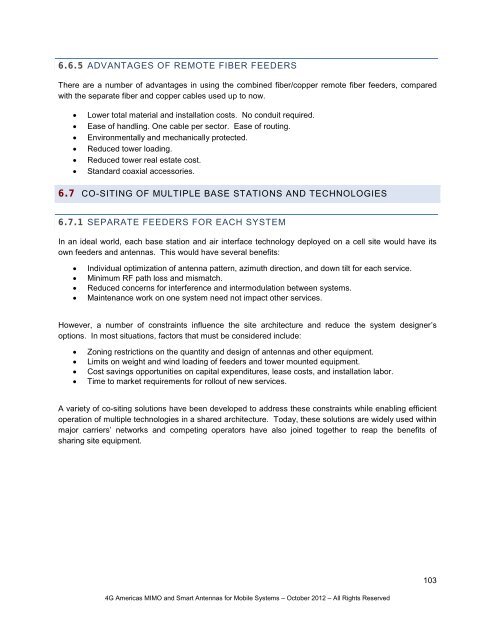MIMO and Smart Antennas for Mobile Broadband ... - 4G Americas
MIMO and Smart Antennas for Mobile Broadband ... - 4G Americas
MIMO and Smart Antennas for Mobile Broadband ... - 4G Americas
You also want an ePaper? Increase the reach of your titles
YUMPU automatically turns print PDFs into web optimized ePapers that Google loves.
6.6.5 ADVANTAGES OF REMOTE FIBER FEEDERSThere are a number of advantages in using the combined fiber/copper remote fiber feeders, comparedwith the separate fiber <strong>and</strong> copper cables used up to now.• Lower total material <strong>and</strong> installation costs. No conduit required.• Ease of h<strong>and</strong>ling. One cable per sector. Ease of routing.• Environmentally <strong>and</strong> mechanically protected.• Reduced tower loading.• Reduced tower real estate cost.• St<strong>and</strong>ard coaxial accessories.6.7 CO-SITING OF MULTIPLE BASE STATIONS AND TECHNOLOGIES6.7.1 SEPARATE FEEDERS FOR EACH SYSTEMIn an ideal world, each base station <strong>and</strong> air interface technology deployed on a cell site would have itsown feeders <strong>and</strong> antennas. This would have several benefits:• Individual optimization of antenna pattern, azimuth direction, <strong>and</strong> down tilt <strong>for</strong> each service.• Minimum RF path loss <strong>and</strong> mismatch.• Reduced concerns <strong>for</strong> interference <strong>and</strong> intermodulation between systems.• Maintenance work on one system need not impact other services.However, a number of constraints influence the site architecture <strong>and</strong> reduce the system designer’soptions. In most situations, factors that must be considered include:• Zoning restrictions on the quantity <strong>and</strong> design of antennas <strong>and</strong> other equipment.• Limits on weight <strong>and</strong> wind loading of feeders <strong>and</strong> tower mounted equipment.• Cost savings opportunities on capital expenditures, lease costs, <strong>and</strong> installation labor.• Time to market requirements <strong>for</strong> rollout of new services.A variety of co-siting solutions have been developed to address these constraints while enabling efficientoperation of multiple technologies in a shared architecture. Today, these solutions are widely used withinmajor carriers’ networks <strong>and</strong> competing operators have also joined together to reap the benefits ofsharing site equipment.<strong>4G</strong> <strong>Americas</strong> <strong>MIMO</strong> <strong>and</strong> <strong>Smart</strong> <strong>Antennas</strong> <strong>for</strong> <strong>Mobile</strong> Systems – October 2012 – All Rights Reserved103
















